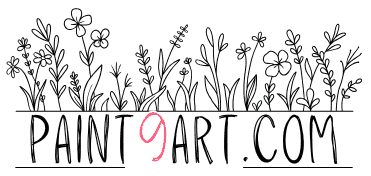Minimalist watercolor art is all about finding beauty in simplicity. With soft strokes, gentle gradients, and plenty of white space, each piece offers a moment of calm in a busy world.
Whether you’re looking to decorate your home with soothing artwork or explore a mindful creative hobby, minimalist watercolor designs are the perfect place to start.
These 24 ideas will inspire you to slow down, experiment, and let the paint flow with ease.

Contents
- 1 24 Minimalist Watercolor Creations
- 1.1 Aqua Shoreline
- 1.2 Earth’s Embrace
- 1.3 Birds of the Golden Sky
- 1.4 Rooted Chroma
- 1.5 Forest Deer
- 1.6 Branches and Blue Hills
- 1.7 Mist & Moss
- 1.8 Cerulean Dreamscape
- 1.9 Circle of Trees
- 1.10 Shadowed Snowscape
- 1.11 Deep Blue Reflections
- 1.12 Silent Growth
- 1.13 Terra Scape
- 1.14 The Verge
- 1.15 Tiny Cabin
- 1.16 Tree on the Brink
- 1.17 Trees Above Gemstone
- 1.18 Trees at Sunset
- 1.19 Trees Beyond the Fog
- 1.20 Twilight Solitude
- 1.21 Under Heavy Skies
- 1.22 Windswept
- 1.23 Winter Dawn
- 1.24 Woodland Divide
- 2 Conclusion
24 Minimalist Watercolor Creations
Aqua Shoreline

Start by sketching a simple, low horizon line with jagged rock shapes. Wet the area below the rocks and drop in diluted indigo or phthalo blue, allowing it to drip downward naturally to create a soft gradient. While still damp, tilt the paper to encourage organic flow, then let it dry completely.
Using a fine brush and the same blue, paint minimal, spindly tree shapes on dry paper for sharp contrast. Keep the composition airy and avoid overworking details to maintain a minimalist feel. Leave the sky untouched to emphasize negative space and create a calm, open atmosphere.

Begin by wetting the bottom half of the paper to prepare for the mirrored reflection. Paint a small island shape with deep blue (such as Indigo or Payne’s Gray) using wet-on-dry for the main landmass and switch to wet-on-wet for soft, atmospheric blending into the water. Add subtle greenery and vertical tree forms using a rigger or liner brush while the base is still slightly damp for softened edges in the background.
For the reflection, lightly drag pigment downward from the land and trees into the wet area, letting it bleed organically. Suggest rocks and their mirrored forms with a dark neutral mix (Burnt Umber + Ultramarine) and keep their placement loose. Let the top of the paper remain untouched to preserve a sense of open space and calm.
Make your home feel curated and serene. Visit our store to discover more printable minimalist wall art.
Earth’s Embrace

Muted greens roll into layered hills, soft and distant, where bare trees mark the curve of the slope like delicate inked etchings. Below, rich earth tones burst outward—burnt sienna and raw umber bleeding into the page, uncontrolled yet grounded.
Two small silhouettes pause on the dark ridge, their presence anchoring the space. Light splattering and edge blooms give the scene life without noise. The paper’s untouched corners breathe around the forms, letting silence and shape hold the emotion.

You press the brush to the paper and let ochre melt into olive, watching the pigments drift outward like breath on glass. The hillside takes shape almost on its own—darker, sloping upward—pulling your eye and your hand with it. You sketch two tiny figures resting on the ridge, just enough detail to suggest closeness, not distraction.
With a fine brush, you ink in leafless trees—elegant and sparse, arching ever so slightly toward each other. The white space feels intentional, protective, like silence wrapped around the scene. You pause before adding more and realize—there’s nothing else needed.
Bring warmth and quiet elegance into your home. Explore our minimalist printable art collection and choose the perfect print.
Birds of the Golden Sky

Start with wetting the paper and applying a smooth gradient wash using a pale golden yellow for the sky. While the paper is still damp, softly blend in violet for the left hillside and a peachy-orange for the right hill, allowing the colors to feather naturally. Let the washes dry completely before moving to detail work.
Using a rigger brush and dark neutral tones (like Payne’s Gray or Indigo), paint bare tree silhouettes with branching lines of varied angles and lengths. Add light shadows beneath the trees to suggest form and placement on the terrain. Finally, paint a few loose bird shapes in the upper sky for movement and balance.

Begin by wetting the paper and applying a smooth gradient wash using a pale golden yellow for the sky. While the paper is still damp, softly blend in violet for the left hillside and a peachy-orange for the right hill, allowing the colors to feather naturally. Let the washes dry completely before moving to detail work.
Using a rigger brush and dark neutral tones (like Payne’s Gray or Indigo), paint bare tree silhouettes with branching lines of varied angles and lengths. Add light shadows beneath the trees to suggest form and placement on the terrain. Finally, paint a few loose bird shapes in the upper sky for movement and balance.
Love this style? Visit the store to browse more minimalist watercolor prints and instantly download artwork that transforms any room.
Rooted Chroma
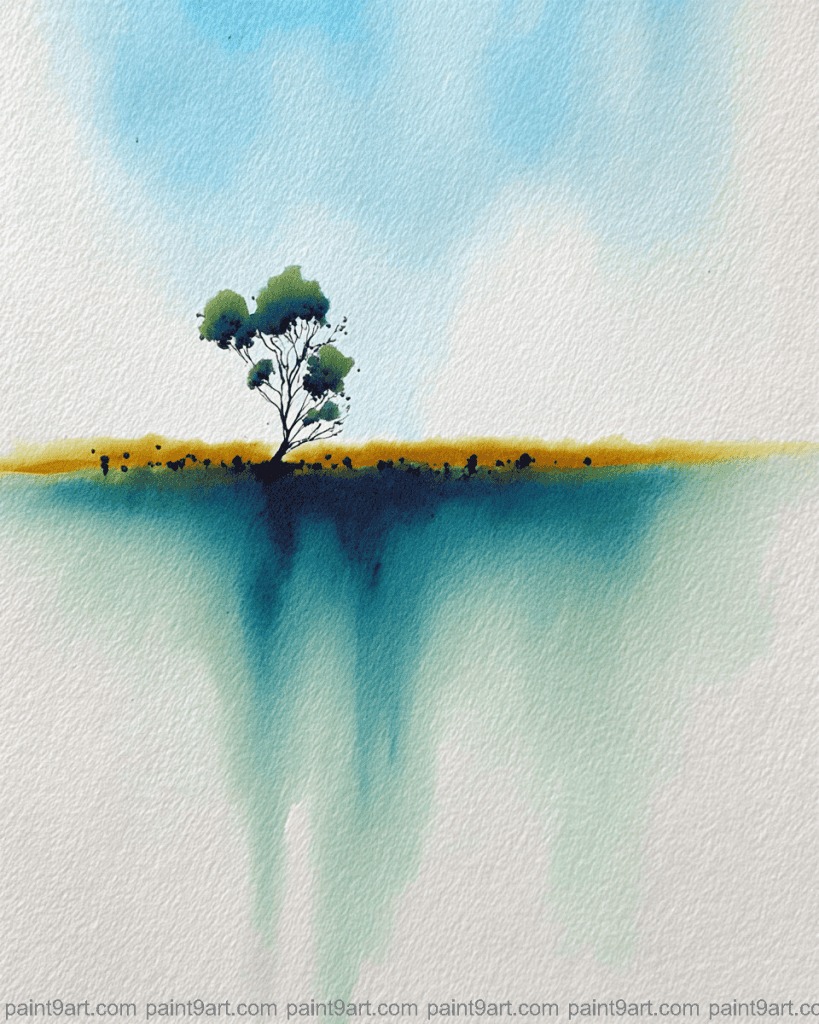
The sky felt too quiet at first, so I pushed a puddle of blue upward and let it bloom into the paper. Watching it feather out gave me that familiar thrill—like watching light shift through glass. I kept the horizon clean and sharp with a dry edge, then dropped in that golden strip, like a field catching the sun just right.
The tree came last. I hesitated with the shape—wanted it to feel unbalanced, slightly wind-blown, imperfect. When I added the bleeding shadow beneath it, the whole piece finally made sense. It wasn’t just a tree anymore—it was something clinging to light, grounded even as the ground dissolved.
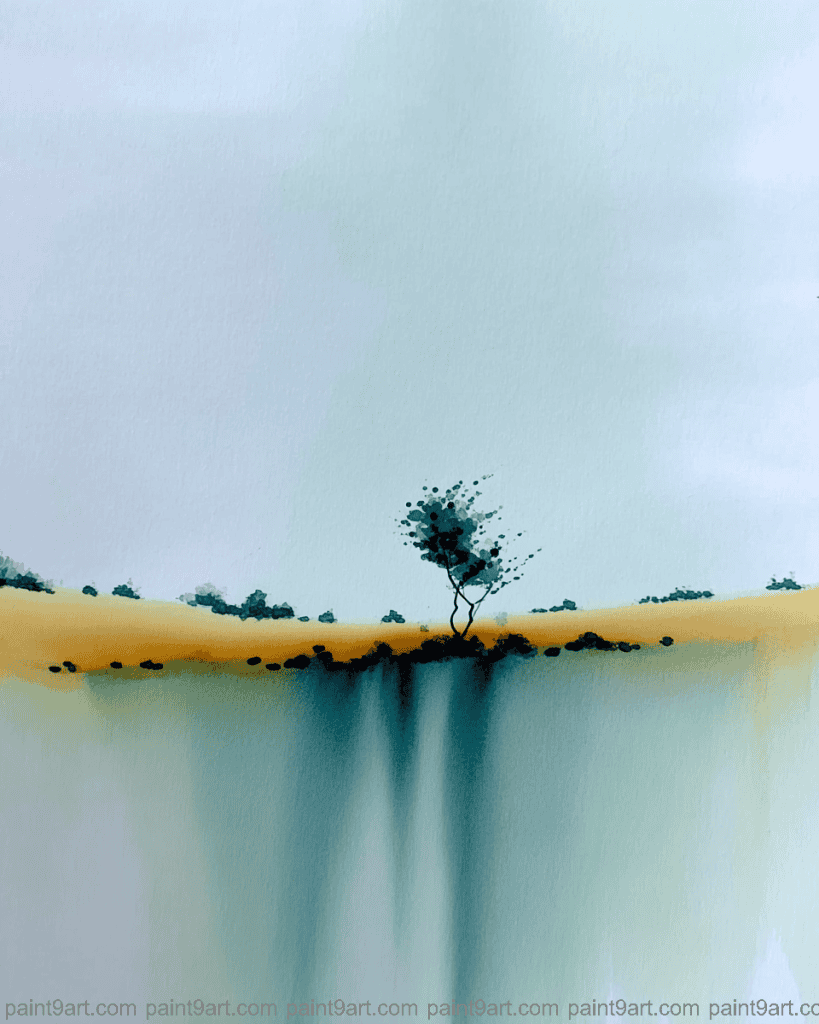
The moment my brush touched the paper, I knew I wanted that empty sky to stay mostly untouched—just the faintest hint of a cool wash to hold everything together. I laid down the ochre strip slowly, letting it bleed gently into the blue below. That contrast, warm meeting cold, always sparks something alive in me.
When it came to the tree, I didn’t want it to feel controlled. I let the brush flick just slightly, adding those irregular splatters to break the calm. The thin trunk, almost trembling in its solitude, stood just enough to carry the piece. As the pigment ran downward, like memories dissolving, I stepped back. It felt honest—lonely, but still rooted.
Make your home feel curated and serene. Visit our store to discover more printable minimalist wall art.
Forest Deer

You let the blue bleed into the paper like fog rolling through the trees, watching it blur and settle into soft silhouettes. A forest begins to emerge—not with detail, but with suggestion—vertical strokes for trunks, some sharper than others, fading into mist.
With a single, confident shape, you place the deer. It stands quiet and still in the center, half-obscured, as if it stepped from a dream. Splattering white across the scene feels like casting snowfall—gentle, random, alive. For a moment, it feels like you’re standing there too, watching the winter hush settle in.

I lay down a soft wash of cool indigo, letting it bleed into pale hints of violet and misty blue. The slope takes shape beneath my brush, gentle but shadowed, and I guide the pigment into subtle movement, like fog curling along the hillside.
You might’ve seen it too—how the trees rise next, bare and spindly, reaching upward in quiet silhouettes. I place the deer just where the light peeks through, antlers catching the soft glow. The scene feels still, yet alive, like I’ve stepped into a hush that’s been waiting here all along.
Bring warmth and quiet elegance into your home. Explore our minimalist printable art collection and choose the perfect print.
Branches and Blue Hills
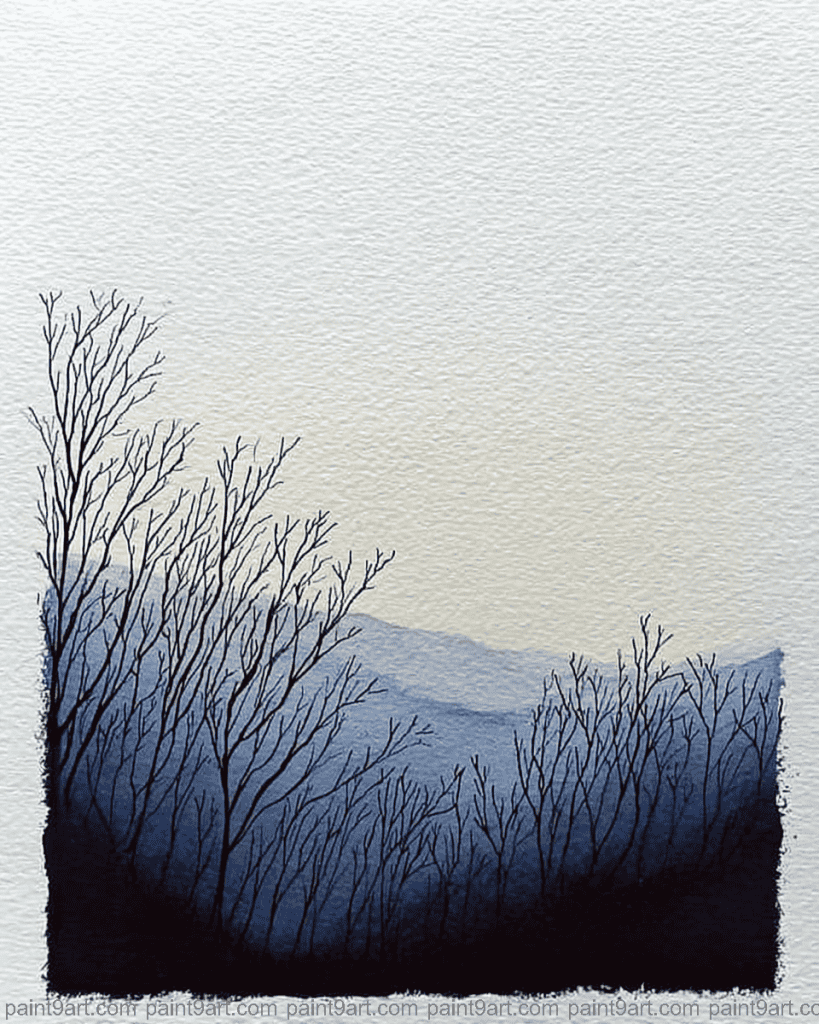
Begin by masking a clean square or rectangular section at the bottom of the paper. Apply a graded wash of cool blues—starting dark at the bottom and fading upward—to create the effect of layered distant hills. Use wet-on-wet to blend the midground hill shapes softly into the background, creating a sense of atmospheric depth.
Once the wash is fully dry, use a fine liner or rigger brush and a deep black or dark indigo to paint the intricate bare branches. Vary the angle and height of each tree for natural rhythm, keeping the branches spindly and delicate. Leave the upper portion of the paper untouched for strong contrast and a minimalist sky.
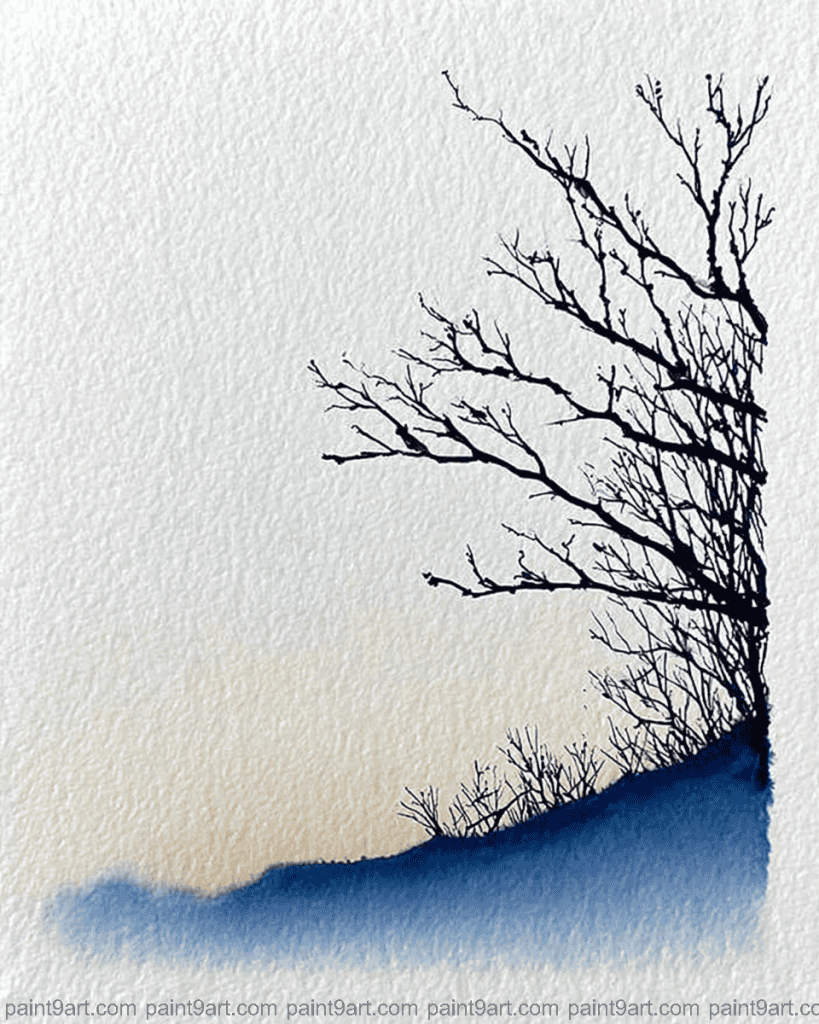
Start with a clean sheet and apply a diluted wash of indigo or Payne’s Gray at the bottom corner, softening the edges outward with clean water to create a foggy slope. Let the paint fade naturally into the paper for a misty, atmospheric base. A hint of warm ochre or diluted orange can be added subtly to the sky to warm the horizon.
Once the background is completely dry, use a fine rigger brush with concentrated dark paint to create a single dominant bare tree and several smaller shrubs along the ridge. Vary line thickness to give the branches an organic feel and keep the forms leaning to the right for directional flow. Keep the composition airy and let negative space do most of the visual work.
Love this style? Visit the store to browse more minimalist watercolor prints and instantly download artwork that transforms any room.
Mist & Moss
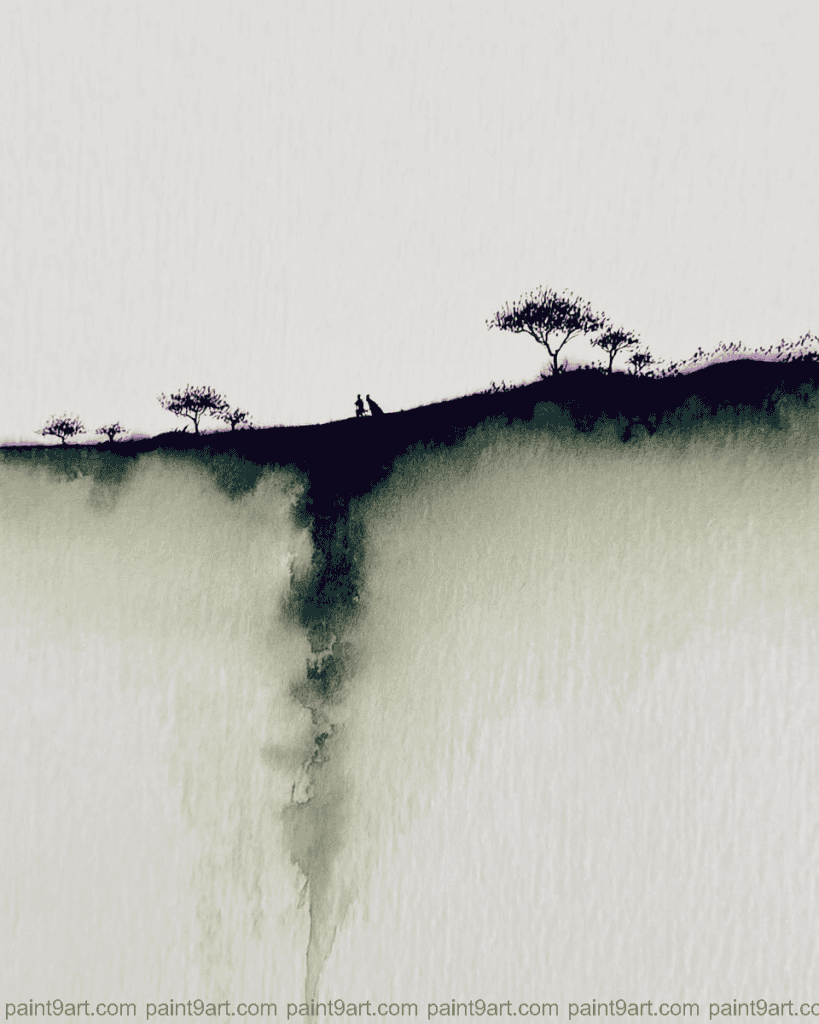
I let the brush drag a soft stroke of deep green across the top, letting gravity pull it downward into that beautiful uncontrolled wash. You know the feeling—it’s like the page is breathing, opening up into an abstract canyon or cliff.
The silhouettes come next: small trees, almost whispers, and two tiny figures facing the same horizon I was staring at when I painted them. There’s something grounding about that—how something so small on the page can hold so much stillness. I didn’t plan the way the green faded into bone-white paper, but I stepped back and realized it looked exactly how silence feels.

I let the green pigment bleed freely down the paper, letting water carry the shadows like rainfall down a cliff. There’s no sketch under it—just intuition guiding the slope, and the color deciding where it wants to settle. That unpredictability is my favorite part.
Once the background dried, I added the silhouettes. Tiny figures standing under sparse trees, just dark enough to pull focus. As I painted them, I imagined myself there—high above the mist, watching clouds brush the mountains, quiet conversation between friends echoing into the distance. The whole piece felt like a memory I hadn’t lived, but one I understood.
Make your home feel curated and serene. Visit our store to discover more printable minimalist wall art.
Cerulean Dreamscape

Begin by wetting the paper and using a mix of turquoise, indigo, and violet to paint abstract hill shapes, allowing the pigments to blend and bloom naturally with the wet-on-wet technique. Tilt the paper slightly for soft drips and feathered edges, keeping the flow organic and loose. Add darker pigment at the base of the central hill for depth, and sprinkle or flick water to lift texture for a misty effect.
Once dry, use a fine brush and dark neutral tones (like Payne’s Gray) to paint tree trunks and loosely stippled foliage. Vary the size and placement of the trees to create a sense of perspective, with larger trees in the foreground and smaller ones receding. Leave the sky and surrounding areas untouched for an open, dreamy composition.

Begin by wetting the bottom portion of your paper and loosely applying a gradient wash of deep teal, indigo, and hints of violet to form a sloping hillside. Use wet-on-wet technique and allow the pigments to naturally diffuse, creating soft edges and atmospheric depth. Add texture by flicking clean water or lifting pigment with a tissue to suggest mist and light.
Once the base is dry, paint tree trunks and foliage at the top of the hill using a dark tone like Payne’s Gray, keeping the brushwork delicate and upward. Add soft grass textures by using a dry brush or flicking upward strokes along the ridge. Leave the sky untouched or lightly tinted to enhance the tranquil, minimalist feel.
Bring warmth and quiet elegance into your home. Explore our minimalist printable art collection and choose the perfect print.
Circle of Trees

Start by wetting a small circular area on the paper and drop in a gradient wash, blending warm ochre at the top into cool violet or gray-blue at the bottom. Allow the colors to flow gently into one another within the wet shape, and let the edges remain soft or slightly irregular for an organic look. Let this dry completely before moving on.
Using a fine liner or rigger brush and a deep black or sepia ink, paint slender tree trunks and sparse branches emerging from the horizon line of the shape. Vary the tree heights and foliage density for rhythm and balance. Keep the rest of the page untouched to enhance the minimalist, meditative quality of the composition.

Begin by applying a light wash of yellow ochre and indigo in a horizontal sweep, letting the colors blend organically with soft edges. Allow the pigment to pool slightly to suggest land and shadow, keeping the brushwork loose and letting the lower half fade into the untouched paper for a reflective, serene effect. Let everything dry fully before adding detail.
Using a fine rigger brush and black paint or ink, paint a cluster of slender tree trunks with varying heights. Add delicate foliage with a stippling or dabbing motion at the top of the canopy to suggest fine leaves without overworking. Keep the negative space around the composition clean to emphasize the simplicity and elegance of the form.
Love this style? Visit the store to browse more minimalist watercolor prints and instantly download artwork that transforms any room.
Shadowed Snowscape
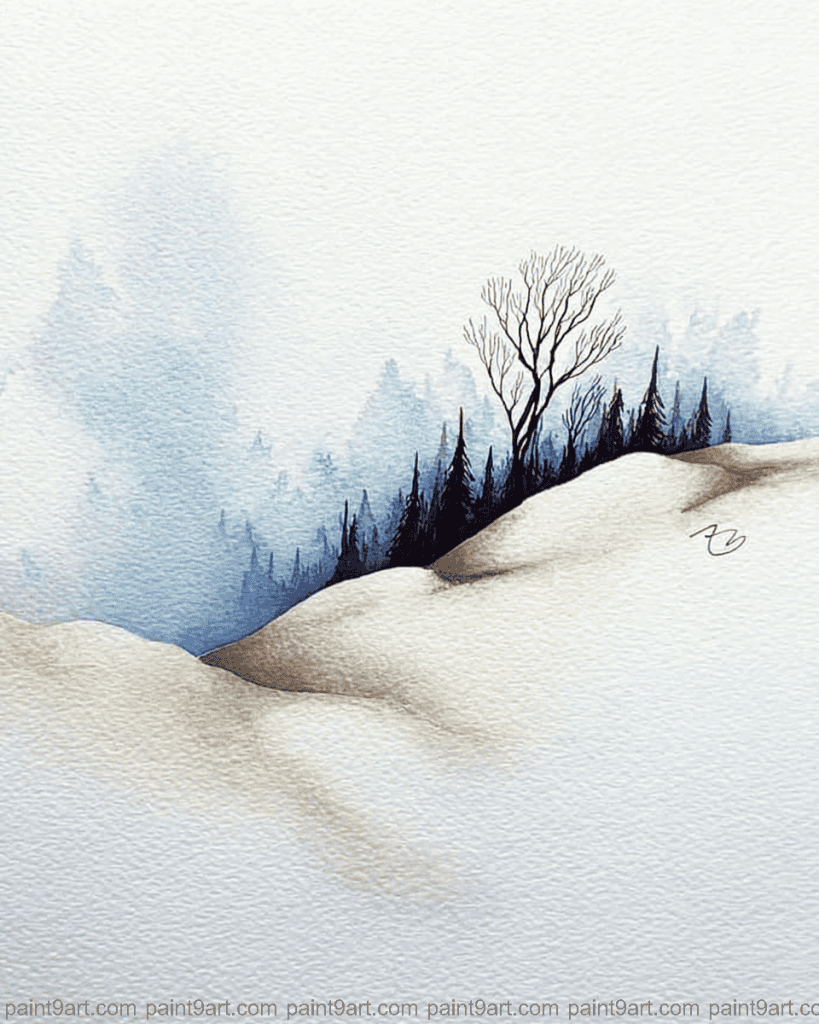
Make your home feel curated and serene. Visit our store to discover more printable minimalist wall art.
Deep Blue Reflections

Begin by painting a dark, concentrated silhouette of trees and ground using a deep indigo or Payne’s Gray on dry paper for crisp edges. While the paint is still wet at the base, tilt the paper downward and use clean water to pull the pigment into a soft, vertical reflection. Let the water create organic drips and blooms to enhance the abstract mirrored effect.
Once the surface is dry, you can add small tree details or a faint hint of color—like the subtle pink glow in the upper background—using a diluted wash. Keep the composition minimal and let the contrast between the white space and deep blue do the visual work. This piece balances precision and spontaneity beautifully.

Soft washes of pastel pink and muted green flow gently across damp paper, merging into a hushed sky. Once dry, a deep stroke of indigo defines the land—sharp, deliberate, holding space for a grove of bare trees and two quiet silhouettes gazing outward.
Dark pigment bleeds downward with water, forming dreamlike reflections. Splattered ink adds tension and texture, suggesting movement beneath the calm. The untouched space around it all holds the story in silence, letting contrast and restraint carry the emotion.
Bring warmth and quiet elegance into your home. Explore our minimalist printable art collection and choose the perfect print.
Silent Growth
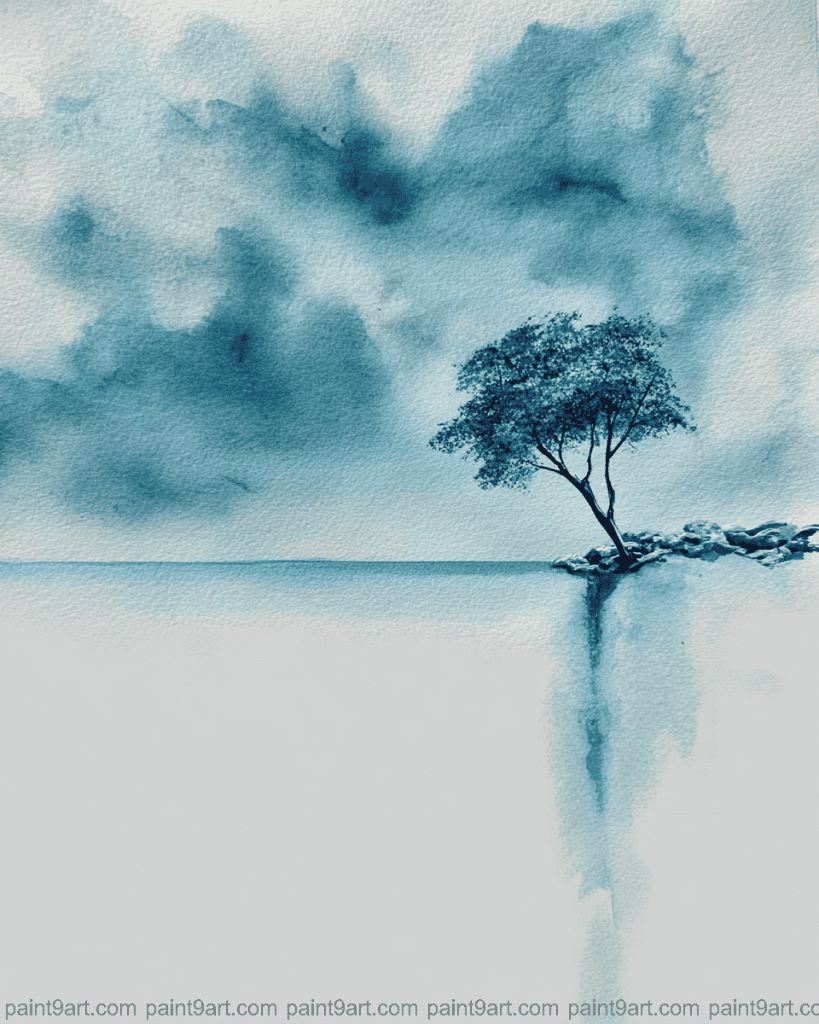
This one came from a place of stillness in me. I remember loading my brush with cerulean and letting the sky unfold on the paper with no real plan—just water and pigment colliding until the clouds felt like breath. I wasn’t chasing form, only feeling.
The lone tree came after everything else had settled. I used a fine liner to build it slowly, letting each branch reach just far enough to hold the air around it. The stones beneath it were a last-minute whisper, like it needed something to stand on besides silence. Watching the blue reflection drip down reminded me of roots that grow inward instead of out. I didn’t say much while painting this—I think the tree said everything I needed to.
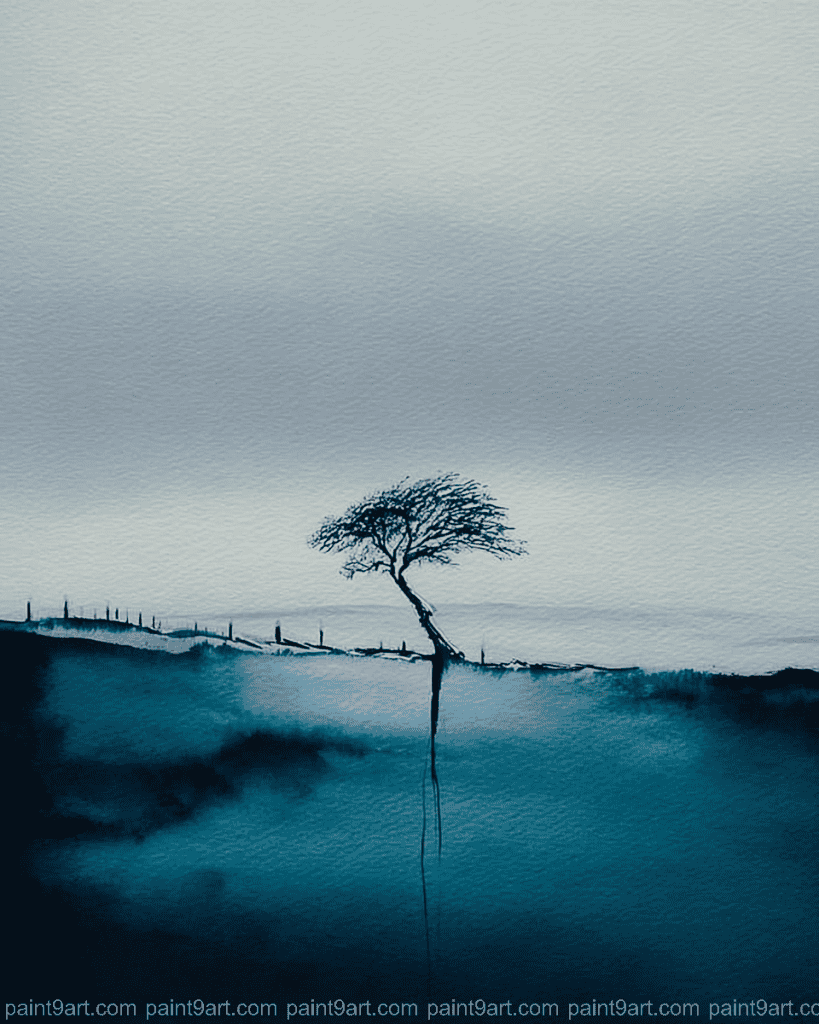
This painting emerged on a gray afternoon when the silence outside matched the space I was holding inside. I remember dragging the brush across damp paper, letting the stormy blue settle in like fog curling over hills. There wasn’t a defined horizon at first—just softness, like breath held too long.
The tree didn’t grow all at once. I let my hand waver, uncertain at first, then steady as the trunk took shape. I thinned the pigment until it bled downward, almost vanishing, like roots dissolving into memory. The curve of the trunk—tilted but not broken—felt personal, as if I was painting a kind of resilience. I stepped back, and it looked lonely, but not lost. That’s when I knew it was done.
Love this style? Visit the store to browse more minimalist watercolor prints and instantly download artwork that transforms any room.
Terra Scape

There was something warm and grounding about this one. I didn’t want dramatic skies or stark contrast—just earth tones and quiet trees. I let the brush glide across the paper with a light wash of burnt sienna, letting it bleed like a memory forming. As the pigment settled, I flicked specks across the slope—small imperfections that made it feel real.
With a fine liner, I drew each tree individually. Their trunks rose from the hill like thoughts unspoken, some reaching, some still. I kept the lines delicate, almost hesitant, like the trees weren’t sure whether to stay or leave. Every time I stepped back, I saw more of myself in their clustered silhouettes—close together but each alone in its stance.
I didn’t plan the composition too rigidly. The land faded off to the right with just a hint of mist, and I let that ambiguity stay. It made the painting breathe, like silence after someone important has just walked out of frame.

This one felt more grounded than usual—like I wanted to feel the weight of the land under my brush. I picked up a warm, reddish-brown pigment and let it sink into the paper. As I tilted the page slightly, the color bled downward, creating natural textures I didn’t plan but decided to keep. The rough edge of the hill just happened—it wasn’t drawn, it emerged.
When I moved to the trees, I used the thinnest liner I had. I wasn’t after realism—just the suggestion of branches, the kind that sway quietly at dusk. I layered some distant shapes in muted blue to give the sense of depth, like fog rolling in behind the slope. Each cluster of trees came out slightly different, like siblings with shared roots but their own posture.
Looking at the finished piece, I didn’t feel like I created a scene. It felt more like I stepped into one I already knew—somewhere I’ve never been, but somehow remember.
Make your home feel curated and serene. Visit our store to discover more printable minimalist wall art.
The Verge
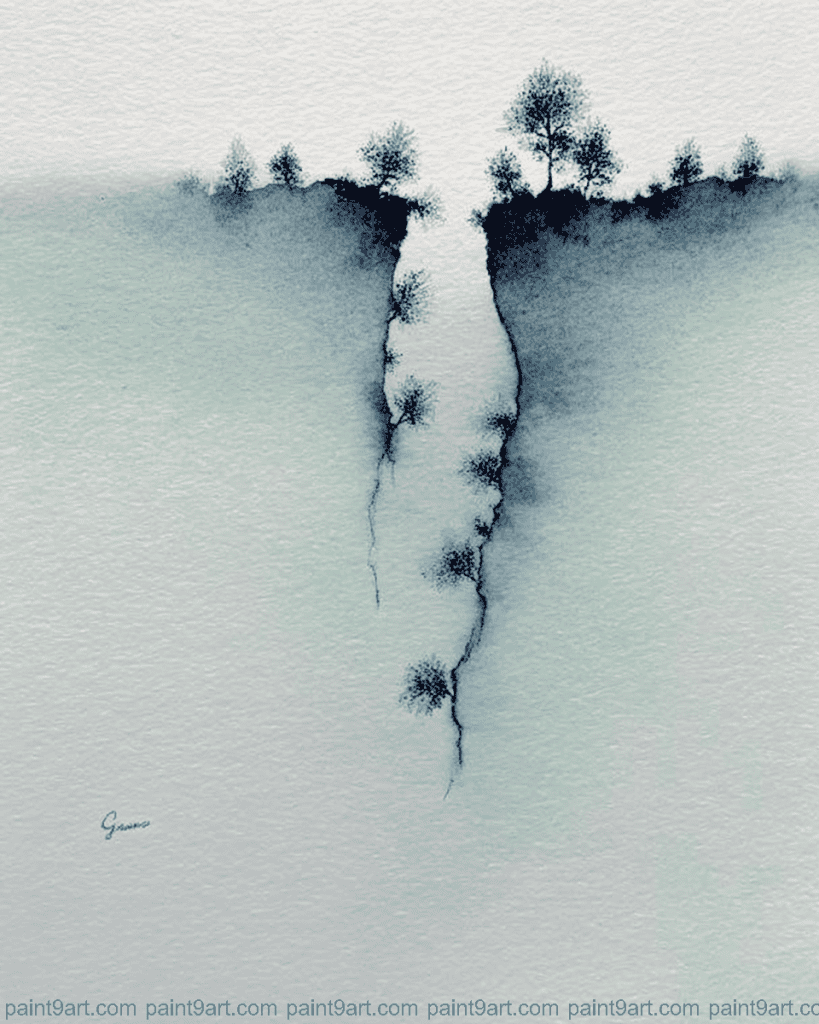
This one came from a quiet place inside me—where things feel divided, but still connected. I let the paper stay mostly untouched. I didn’t want to say too much. I wanted the emptiness to do some of the talking.
I loaded my brush with a soft, muted teal and gently swept it outward from the edges. No outlines—just letting the pigment pool and spread, like breath fading into cold air. The rift between the two cliffs needed to feel fragile, so I used the tip of my brush to suggest a thread of erosion, then faded it away with water.
When I painted the trees, I imagined them clinging to the edge, like thoughts that won’t let go. Each one was placed with care—tiny marks, barely-there textures. As I stepped back, I felt the pull between both sides. Not a gap, really, but a space waiting for something—or someone—to cross it.
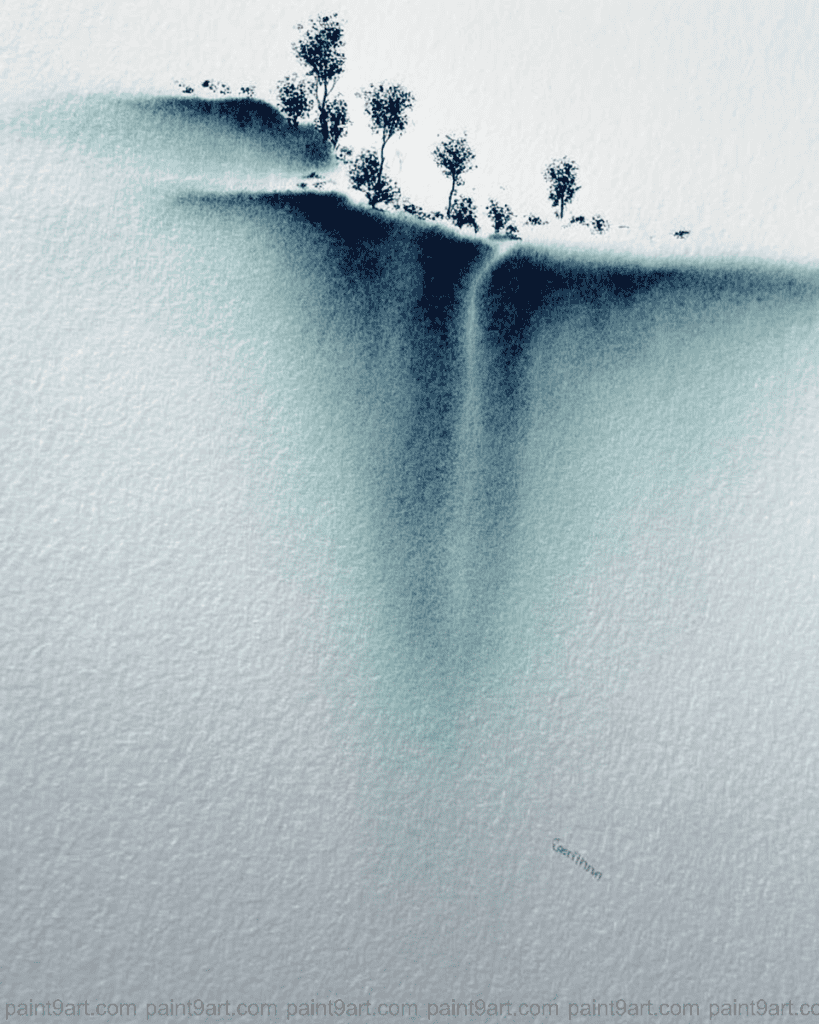
I started by letting a wash of teal and gray bleed softly down the page, guiding it just enough to suggest a steep drop. The way the pigment moved felt like mist pouring into emptiness.
Once it dried, I added a row of delicate trees at the top—thin, still, barely holding on. Each one leaned slightly, as if listening to the quiet below. The whole piece feels like standing at the edge of something forgotten.
Bring warmth and quiet elegance into your home. Explore our minimalist printable art collection and choose the perfect print.
Tiny Cabin

I let the mist guide my first strokes, using diluted blue-gray to softly shape the cliff as it disappeared into the blank space below. The paper did most of the work for me—letting the pigment bleed gently, creating that weightless, foggy edge. It felt like the landscape was breathing, quiet and untouched.
I painted the trees next, carefully placing their bare, fine branches to suggest both fragility and stillness. Then came the little cabin, a warm red-brown shape nestled among the trees, just enough to draw the eye without disturbing the calm. With each layer, I wasn’t painting a scene—I was holding a quiet moment still.

The sky came first—lavender fading into soft dusk, dotted with specks of white for stars. I worked wet-on-wet to get that smooth transition, letting the paper drink in the color and soften the edges. As it dried, I added the thin trees, tall and leafless, rising quietly around a tiny orange cabin tucked into the middle.
With a flat brush and muted greens, I layered the land and reflected the trees downward with quick, watery strokes. The reflection didn’t need to be exact—just enough to feel like it belonged. Painting this felt like standing at a distance, watching a peaceful evening unfold somewhere I could only reach through the brush.
Love this style? Visit the store to browse more minimalist watercolor prints and instantly download artwork that transforms any room.
Tree on the Brink

I painted this scene with a sense of quiet tension in mind. The moment I laid the first wash of rust onto the cliffside, I felt like I was shaping a fragile edge—one where a single tree leans bravely over a vast drop. The inked trees came next, drawn with a fine liner to contrast the loose watercolor textures.
I used a cooler wash for the water below, letting the paint flow and pool naturally. Some of the ripples, I guided with a gentle brush flick, just enough to suggest motion. As the birds lifted off in the distance, I felt the whole scene breathe—balanced between stillness and the endless space beyond.

This piece felt like painting a memory. As the paper drank up the soft browns and rusts of the clouds, I imagined standing alone at the edge of the world, letting the silence of altitude settle in my chest. That tiny figure under the tree—that was me, in a way, just observing, letting the scene speak.
I kept the sky light, using splatters for movement and atmosphere. The rocks and pines came with darker strokes, firm yet minimal, meant to ground the floating feeling. It’s a simple painting, but it holds something quietly enormous.
Make your home feel curated and serene. Visit our store to discover more printable minimalist wall art.
Trees Above Gemstone

This one felt like standing at the edge of a dream. The background mountains—purples and blues—barely hold their shape, like a memory fading. I let the colors run where they wanted, trusting the softness would carry the weight of the scene. That vertical cliff of green? It wasn’t planned—it just appeared and became the anchor.
The trees were drawn slowly, one by one, their bare branches reaching like quiet thoughts. Behind them, a warm glow peeks out, hinting at either dawn or farewell. There’s not much detail, but something about it feels complete—just enough said, and the rest left in silence.

I painted this one imagining what it might feel like to cling to the edge—not out of fear, but out of awe. The cliff formed itself in layered purples and teals, like a staircase carved by wind and time. Each level holds a tree, each tree a story. I felt like I was slowly descending a thought, one branch at a time.
The trees at the top are clustered, like friends watching the sun rise together. Below, the others stretch alone, quiet, grounded but reaching. It’s less about the cliff and more about the climb—the space between holding on and letting go.
Bring warmth and quiet elegance into your home. Explore our minimalist printable art collection and choose the perfect print.
Trees at Sunset

This piece was born from a quiet moment—just me, some ochres and blues, and the feeling of standing still while everything slowly fades into dusk. I let the paper drink the sunset while the bare trees reached into its warmth. That little cabin? It wasn’t planned. It just showed up, like a thought I hadn’t realized I was thinking.
The textures flowed freely, the water doing half the work while I guided it gently uphill. There’s something comforting about how it all leans to one side, as if the whole hill is taking a breath. I think this one holds silence well.

This one felt like painting a pause. Just a slope, a few trees, and the hush of orange light spilling over a mountain I barely outlined. I kept my hand loose so the blue would drift like cool air down the hill. Nothing here needed detail—just the idea of a place you’ve passed once and never forgotten.
The tallest tree stands slightly apart from the others, like it’s listening for something. That wasn’t planned, but it stayed. I like how the white space does most of the talking.
Love this style? Visit the store to browse more minimalist watercolor prints and instantly download artwork that transforms any room.
Trees Beyond the Fog

These trees came out of silence—just brush, water, and a slow build of shadows. I wanted the scene to feel like it’s holding its breath, caught between stillness and memory. The mist barely parts around the trees, and the ground seems to dissolve into it.
The background mountains, softened with pale grey, don’t fight for attention. They just sit there, watching. I think that’s what I liked most about this one—it didn’t need much. The emptiness carries the weight.

This one feels like a quiet inhale—like that moment just before something shifts. The fog creeps in slowly, settling between the hills, softening every line until only the trees remain clear. I didn’t want to overwork it. Just a suggestion of the land and that one dark slope cradling the cluster of trees.
The rest of the space—wide, pale, and still—is meant to be held open. I like how it makes you pause, how the emptiness stretches time. There’s not much happening, and yet, that’s the point.
Make your home feel curated and serene. Visit our store to discover more printable minimalist wall art.
Twilight Solitude

The colors arrived first—soft sky blues and that sudden streak of rust like a memory breaking through. I wanted the land to feel like it’s receding, like it’s giving way to something quieter. It’s not really about the trees or even the shoreline, but that feeling of looking out, wondering where the water ends and the sky begins.
The brush lifted here more than it pressed. That’s the rhythm I followed: pull back, then let go. It’s a moment caught between hush and horizon, where nothing moves—but everything hums.

This piece drifted into being like a fading memory—quiet, loose, untethered. I let the water carry most of the weight, guiding pigment until it found its own calm shape. The sky turned golden too easily, like the day was already giving in to something gentler.
The plants came last—just a hint of form where everything else blurs. They ground the light, almost defiantly, without interrupting the hush. It’s a stillness that feels both final and forgiving.
Bring warmth and quiet elegance into your home. Explore our minimalist printable art collection and choose the perfect print.
Under Heavy Skies

The sky in this piece took on a life of its own—dense, fluid, and unpredictable. I let the paint bloom and bleed, watching it form thunderous shapes like a storm still deciding whether to break. It wasn’t about control here, just presence.
The tree below bends but doesn’t yield. It stands alone, held low by unseen wind, grounded against the weight of all that sky. There’s a tension between the vast above and the fragile below—a quiet defiance that somehow makes the silence feel louder.

This one felt like watching a memory form—the clouds swirling in burnt sienna, restless and unsettled. I didn’t try to tame them. They needed to spill freely, like the sky remembering something it once held and then lost.
The trees lean forward, shaped by years of wind and silence. They echo the movement above, but hold their own rhythm, grounded in blue earth and fading light. In their curve is endurance—weathered, but still reaching.
Love this style? Visit the store to browse more minimalist watercolor prints and instantly download artwork that transforms any room.
Windswept

This painting captures resilience in motion. A lone, wind-bent tree clings to the earth, its branches flung back as though shaped by years of enduring the same gust. The landscape is softened by mist and fading blues, giving the scene a dreamlike quiet.
The background melts into pale amber light, warm yet distant, like the promise of calm that never quite arrives. Everything feels suspended between strength and surrender. It’s a portrait of persistence—still standing, still rooted, still here.

This piece feels like a quiet inhale before a storm—just wind and breath moving through the land. The sparse trees bend without breaking, shaped by forces that came long before them and will outlast them still.
There’s a cold softness to the palette—blues that blur like memory, and the faint shape of a house, distant and tucked against the hills. It’s not loneliness exactly, but a kind of solitude that listens.
Make your home feel curated and serene. Visit our store to discover more printable minimalist wall art.
Winter Dawn

This watercolor evokes a serene winter morning, where the hush of dawn meets the quiet resilience of bare trees. Three leafless silhouettes stand still against a backdrop of soft blues and fading night, their branches reaching upward like questions to the pale sky.
The subtle glow of yellow near the horizon hints at warmth just beginning to rise. A few birds break the stillness, in motion while everything else remains grounded. It’s a quiet moment of transition—where darkness surrenders to light, and stillness yields to the first breath of a new day.

This painting feels like standing alone in a quiet forest clearing just as the first light breaks through. The branches stretch inward from either side, framing the pale, glowing center like a gentle spotlight from the sky. Their bare limbs seem to whisper to one another, carrying the weight of winter with elegant stillness.
Above, a small flock of birds drifts into view, their motion contrasting the trees’ stillness. The cool blues anchor the scene in chill and shadow, while the soft yellow hints that warmth is slowly returning. There’s a breathlessness to this moment—like the world is holding still, waiting for the sun to rise just a bit higher.
Bring warmth and quiet elegance into your home. Explore our minimalist printable art collection and choose the perfect print.
Woodland Divide

It feels like I’m standing right on the ridge, looking across a quiet gap between two steep forested slopes. The trees are sparse and spindly, reaching upward like they’re clinging to the last bits of light drifting through the mist. Each side of the divide carries its own weight, darkened by shadows and washed with earthy tones that seem to whisper stories of solitude.
In the middle, that small clearing offers a breath—a pause between two dense thoughts. There’s something both calm and unresolved about it, like the moment before a decision is made or a step is taken. The silence here isn’t empty; it’s full of something just out of reach.
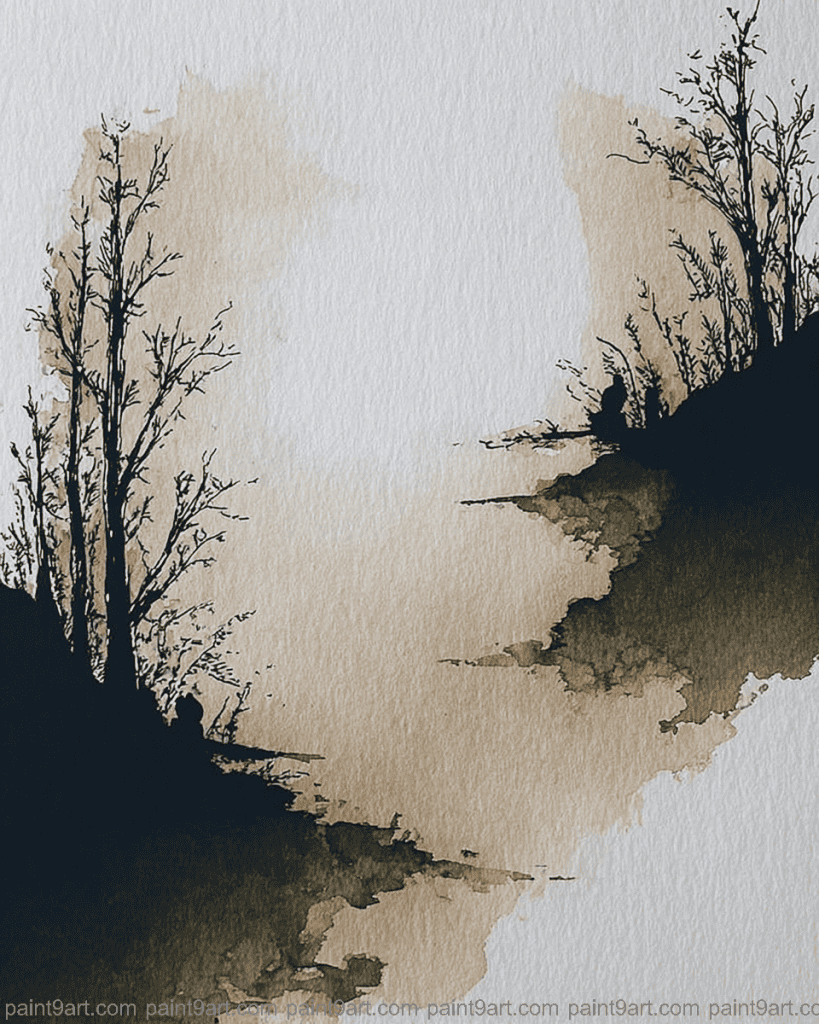
I’m standing on one side of the ravine, peering across to where the trees thin into delicate silhouettes against the soft, open space. The air is thick with stillness, yet it hums with a quiet tension—like something waits in the void between these shadowed slopes. My eyes trace the faint watercolor washes that bleed into each other, grounding the landscape in earthy uncertainty.
It feels as if time holds its breath here. The divide isn’t just geographical—it’s emotional. On my side, the trees press close, almost protective. Across the gap, they seem more distant, sharper, less forgiving. I’m not sure whether to stay or step forward.
Love this style? Visit the store to browse more minimalist watercolor prints and instantly download artwork that transforms any room.
Conclusion
Minimalist watercolor art proves that beauty doesn’t need to be complicated. With just a few brushstrokes and subtle color blends, these ideas can turn any blank canvas into a calming piece of decor. Whether you’re a beginner or a seasoned artist, try a few of these designs and let simplicity become your signature style.

